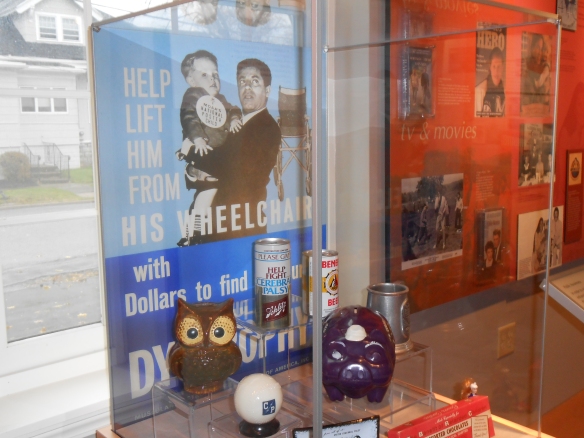Yesterday, I visited The Museum of disABILITY History, located at 3826 Main Street, Buffalo, New York. I finally got to meet David Mack-Hardiman, Director of Training, People Inc., who gave me a tour of the museum, and Douglas V. Farley, Museum Director. I was very impressed with all the displays! This museum has so much to offer including Educational Resources, Activities, Traveling Exhibits, Cafe, and Museum Store. Please visit the museum if you have the chance!
My favorite exhibit, “The Monument For The Forgotten” was the vision of David Mack-Hardiman, created by Brian Nesline, Faces of Buffalo, “featuring thousands of individual grave markers woven into a mosaic tapestry image of a large stone monument.” I need to acknowledge the selfless work that David and People Inc. have done over the past few years. David and his team go into these unmarked cemeteries, clear the brush away, mow the lawns, and raise and clean each marker. Some graves are flat, numbered markers while others, as in the case of a few New York State Custodial Institutions, have the names inscribed. This back-breaking work is done by volunteers! God Bless Them!
“Mission: The Museum of disABILITY History advances the understanding, acceptance, and independence of people with disabilities. The Museum’s exhibits, collections, archives and educational programs create awareness and a platform for dialogue and discovery.
Vision: The Museum seeks with, and on behalf of, individuals with developmental and other disabilities, a higher level of societal awareness and understanding, and a change in attitudes, perceptions and actions that will result in people with disabilities having the greatest possible participation in their communities.”
“Established in 1998 by Dr. James M. Boles, president and CEO of People Inc. (Western New York’s leading non-profit human services agency) the Museum of disABILITY History has steadily expanded over the years and, in late 2010, moved to a brand new location (pictured above). The Museum of disABILITY History is dedicated to advancing the understanding, acceptance and independence of people with disabilities. The Museum’s exhibits, collections, archives and educational programs create awareness and a platform for dialogue and discovery. The Museum of disABILITY History is a project of People Inc. and is chartered by the New York State Department of Education Board of Regents. People Inc. exists so that individuals with disabling conditions or other special needs have the supports they need to participate and succeed in an accepting society. As noted throughout the site, this project has been developed with the generous support of People Inc. and the B. Thomas Golisano Foundation. We are truly thankful for their participation in this worthwhile effort.”




























